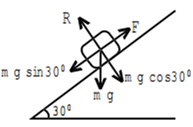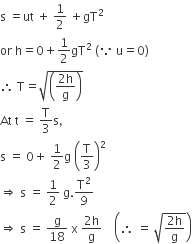Laws Of Motion
Sponsor Area
A block rests on a rough inclined plane making an angle of 30° with the horizontal. The coefficient of static friction between the block and the plane is 0.8. If the frictional force on the block is 10 N, the mass of the block (in kg) is (take g = 10 m/s2 )
-
2.0
-
4.0
-
1.6
-
2.4
2.0
4.0
1.6
2.4
A.
2.0
Let the mass of block be m.
Frictional force in rest position
F = mg sin 30

Sponsor Area
A ball is released from the top of a tower of height h metres. It takes T seconds to reach the ground. What is the position of the ball in T/3 seconds?
-
h/9 metres from the ground
-
7h/9 metres from the ground
-
8h/9 metres from the ground
-
17h/18 metres from the ground.
C.
8h/9 metres from the ground

second law of motion

Hence, the position of ball from the ground= h- h/9 = 8h/9 m
A ball of mass 0.2 kg is thrown vertically upwards by applying a force by hand. If the hand moves 0.2 m which applying the force and the ball goes upto 2 m height further, find the magnitude of the force. Consider g = 10 m/s2
-
22 N
-
4 N
-
20 N
-
30 N
C.
20 N
mgh = Fs
F = 20 N
A block of mass ‘m’ is connected to another block of mass ‘M’ by a spring (mass less) of spring constant ‘k’. The blocks are kept on a smooth horizontal plane. Initially the blocks are at rest and the spring is stretched. Then a constant force ‘F’ starts acting on the block of mass ‘M’ to pull it. Find the force on the block of mass ‘m’.
-
mF/M
-
(M+m)F/m
-
mF/(m+ M)
-
MF (m+M)
C.
mF/(m+ M)
A block of mass 0.50 kg is moving with a speed of 2.00 m/s on a smooth surface. It strikes another mass of 1.00 kg and then they move together as a single body. The energy loss during the collision is
-
0.16 J
-
1.00 J
-
0.67 J
-
0.34 J
C.
0.67 J
m1u1 + m2u2 = (m1 + m2)v
v = 2/3 m/s
Sponsor Area
Mock Test Series
Mock Test Series





